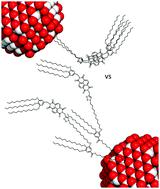当前位置:
X-MOL 学术
›
Nanoscale Horiz.
›
论文详情
Our official English website, www.x-mol.net, welcomes your feedback! (Note: you will need to create a separate account there.)
Electron accepting naphthalene bisimide ligand architectures for modulation of π–π stacking in nanocrystal hybrid materials
Nanoscale Horizons ( IF 9.7 ) Pub Date : 2020-09-03 , DOI: 10.1039/d0nh00359j Katherine C. Elbert 1, 2, 3, 4 , Mohammad M. Taheri 3, 4, 5, 6 , Natalie Gogotsi 2, 3, 4, 7 , Jungmi Park 1, 2, 3, 4 , Jason B. Baxter 3, 4, 5, 6 , Christopher B. Murray 1, 2, 3, 4, 7
Nanoscale Horizons ( IF 9.7 ) Pub Date : 2020-09-03 , DOI: 10.1039/d0nh00359j Katherine C. Elbert 1, 2, 3, 4 , Mohammad M. Taheri 3, 4, 5, 6 , Natalie Gogotsi 2, 3, 4, 7 , Jungmi Park 1, 2, 3, 4 , Jason B. Baxter 3, 4, 5, 6 , Christopher B. Murray 1, 2, 3, 4, 7
Affiliation

|
Investigation of charge transfer in quantum dot (QD) systems is an area of great interest. Specifically, the relationship between capping ligand and rate of charge transfer has been studied as a means to optimize these materials. To investigate the role of ligand interaction on the QD surface for electron transfer, we designed and synthesized a series of ligands containing an electron accepting moiety, naphthalene bisimide (NBI). These ligands differ in their steric bulk: as one allows for π–π stacking between the NBI moieties at high surface coverages, while the other does not, allowing for a direct comparison of these effects. Once grafted onto QDs, these hybrid materials were studied using UV-Vis, fluorescence, and transient absorption spectroscopy. Interestingly, the sample with the fastest electron transfer was not the sample with the most NBI π–π stacking, it was instead where these ligands were mixed amongst oleic acid, breaking up H-aggregates between the NBI groups.
中文翻译:

电子接受萘双酰亚胺配体结构用于调制纳米晶体杂化材料中的π-π堆积
量子点(QD)系统中电荷转移的研究是一个非常令人感兴趣的领域。具体地,已经研究了封端配体与电荷转移速率之间的关系作为优化这些材料的手段。为了研究配体相互作用在QD表面上对于电子转移的作用,我们设计并合成了一系列含有电子接受部分萘双酰亚胺(NBI)的配体。这些配体的空间体积有所不同:一种配体允许在高表面覆盖率的NBI部分之间形成π-π堆积,而另一种不允许,可以直接比较这些作用。一旦接枝到QD上,就使用UV-Vis,荧光和瞬态吸收光谱研究了这些杂化材料。有趣的是
更新日期:2020-09-08
中文翻译:

电子接受萘双酰亚胺配体结构用于调制纳米晶体杂化材料中的π-π堆积
量子点(QD)系统中电荷转移的研究是一个非常令人感兴趣的领域。具体地,已经研究了封端配体与电荷转移速率之间的关系作为优化这些材料的手段。为了研究配体相互作用在QD表面上对于电子转移的作用,我们设计并合成了一系列含有电子接受部分萘双酰亚胺(NBI)的配体。这些配体的空间体积有所不同:一种配体允许在高表面覆盖率的NBI部分之间形成π-π堆积,而另一种不允许,可以直接比较这些作用。一旦接枝到QD上,就使用UV-Vis,荧光和瞬态吸收光谱研究了这些杂化材料。有趣的是



























 京公网安备 11010802027423号
京公网安备 11010802027423号